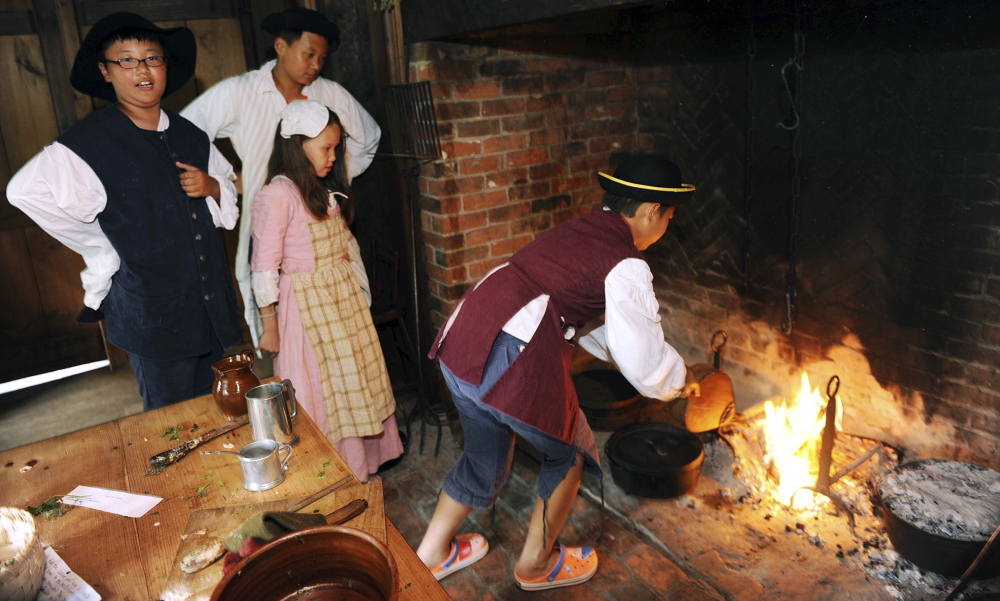DEERFIELD, Mass. — Surrounded by a small group of Asian children dressed in authentic 17th-century Colonial attire, Pocumtuck Valley Memorial Association artist-in-residence Reba-Jean Shaw-Pichette took a handful of loose herbs and began passing around sprigs.
“The way to tell what it is,” said Shaw-Pichette, as she demonstrated how the herbs would have been identified in the Colonial period in front of the Indian House Children’s Museum in Old Deerfield, “is to take it with your fingers and crush it.”
Gingerly taking the leaves from Shaw-Pichette’s hand, Jerry Fu, 9, of China, cracked the stem and raised it to his nose.
“Lemon balm!” he exclaimed.
“Yes, lemon balm! Good job. Now, to dry them out we have to hang them upside-down,” said Shaw-Pichette, demonstrating how to bundle the herbs together and tie them to the handrail of the front stairs leading into the museum, where the children would spend the night.
The children, who have traveled from China, Japan, South Korea and Kazakhstan, came to the museum as part of the Bement School’s English Immersion summer program. The sleepover event is designed as a Colonial history lesson to accompany the academic classes that the children have taken during the day and a series of field trips around New England, said Emily Lent, the program’s director.
Lent said the summer program has been held each year for over a decade, but this is the first time the school has collaborated with the PVMA to teach the children about colonial history.
“We were looking for ways to make the program’s academic aspect more robust, and this was one way we did it,” said Lent, who teaches English and history at the school during the regular academic year.
Lent said the primary goal of the three-week program is to help the children develop their English language skills, and the events that were held in association with the PVMA – which included ballroom dancing, basket weaving, sewing and papercraft – were integrated into the curriculum to expose the children to vocabulary that was used in earlier times.
The field trips, she said, included visits to the Boston Science Museum, Mystic Aquarium, and Pawtucket Red Sox games in Rhode Island.
She said many of the children are enrolled in the program by their parents to help prepare them to spend a full year at a boarding school like Bement.
“They gain so much confidence, and they’re much more excited to speak and really put themselves out there,” said Lent.
Tim Neumann, the executive director of PVMA, said participating in the program was a good way to work with another local institution and to reach an international audience.
He said the organization was inspired to participate in the program by similar programs that have been run by larger museums across the country, such as the Metropolitan Museum of Art in New York City.
“We did the same thing, but on a smaller scale,” he said. “We were inspired.”
Neumann said the advantage of incorporating a museum like the PVMA into an English immersion program is that it provides the students with a more in-depth perspective of the English language, using words and expressions from an earlier period.
“In other scenarios, like modern sports, for instance, that’s not possible,” he said.
Over the course of the night, Shaw-Pichette and other museum staff members guided the children through various chores and taught them new skills, including carding and spinning wool and cooking over a hearth.
In the building’s kitchen, the children helped cut cheese, roll dough and churn buttermilk as they put together a feast of blueberry pie and fricassee, a soup made from mushrooms, cream, lemon juice and herbs, according to Lynne Manring, director of the PVMA’s Deerfield Teacher’s Center. Constant pounding sounds echoed from the second floor, where other children sat smashing and grinding sugar for use in the pies.
Outside, another group of children got the chance to play with toys that were popular in Colonial times, including a pair of stilts, and on the front lawn, other children lined up to learn how to use a yoke to carry buckets of water.
Catherine Yao, 11, of Shenzhen, China, said working with the antique tools was fun, but difficult.
“It’s interesting, but a little hard sometimes,” Yao said. “The things are easy to break, because they’re so old.”
Moments later, Shaw-Pichette found herself demonstrating how to repair one of the yoke buckets after a piece fell off of it.
“It’s a little bit like time traveling,” said Jamie Jeong, 10, of Jeju Island, South Korea, of the experience, as she churned buttermilk in the kitchen sink. “It’s been really amazing.”
Send questions/comments to the editors.



Success. Please wait for the page to reload. If the page does not reload within 5 seconds, please refresh the page.
Enter your email and password to access comments.
Hi, to comment on stories you must . This profile is in addition to your subscription and website login.
Already have a commenting profile? .
Invalid username/password.
Please check your email to confirm and complete your registration.
Only subscribers are eligible to post comments. Please subscribe or login first for digital access. Here’s why.
Use the form below to reset your password. When you've submitted your account email, we will send an email with a reset code.